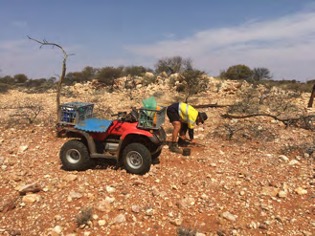DEVEX drilling expands rare earths at Kennedy Project

DevEx Resources (ASX: DEV) has further significantly expanded the footprint of total rare earth oxide (TREO) mineralisation in surface clays with recent air-core drilling at the Kennedy Ionic Clay-Hosted REE Project in North Queensland.
Importantly, shallow TREO assay results include the important and high-value MREO’s – Praseodymium (Pr6O11), Neodymium (Nd2O3), Dysprosium (Dy2O3) and Terbium (Tb4O7), which are essential in the manufacture of permanent rare earth magnets used in electric vehicles and numerous other renewable energy applications.
The company is strategically targeting these MREO’s, and particularly mineralised zones where they concentrate, in both grade and thickness.
The company has identified two priority areas where drilling has defined higher-grade MREO mineralisation in surface clays, with the northern area (Area A) extending over an area of up to 10km x 6km. The two priority MREO areas lie within a much broader region of TREO mineralised clays that remain only partially tested on broad drill spacing.
Drilling within both priority areas has identified that the tertiary clays (Target Regolith) which host the target MREO’s are typically unconsolidated loose clays mixed with poorly sorted pisolite material.
Previous metallurgical test work from Area A confirmed that the rare earth mineralisation has formed as Ionic Adsorption REE Clays, with leach testwork demonstrating that rapid recoveries can be achieved by desorption of REE’s in the first 30 minutes using a weak acid (pH4) ammonium sulphate solution.
The Kennedy Ionic Clay REE Project remains one of only a select few ionic clay projects that has been defined in Australia to date.
Drilling and preliminary metallurgical work completed to date has identified several favourable attributes to the deposit including:
- Shallow: The mineralisation occurs from surface with minimal to no overlying waste rock.
- Soft: The rare earths lie in unconsolidated clays with poorly sorted pisolite and nodules dispersed amongst the clays.
- Favourable Metallurgy: Preliminary leach test work demonstrates rapid recoveries by desorption of REE in the first 30 minutes using ammonium sulphate solution in weak acidic conditions (pH4) with very low acid consumption and very low dissolution of gangue elements including calcium. These outcomes are key attributes of ionic adsorption clay REE mineralisation.
- Significant Scale: With elevated rare earths occurring in surface clays throughout the project area, the company says two areas (Areas A and B) where relatively higher-grade MREOs appear to be concentrating. These two areas themselves are extensive, with Area A defined over an area of 10km x 6km.


